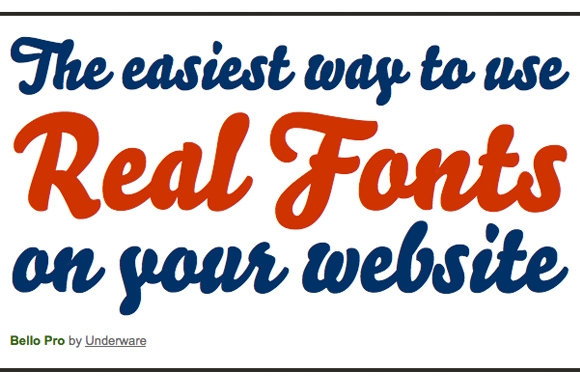
In the world of web design, using typefaces other than the very limited list of cross platform system fonts has meant using images, flash or some other piece of webtrickery, often resulting in content being difficult to update, format or index in search engines. This has meant that most web designers have simply stuck to the usual stack of well known and safe options – Arial, Georgia, Comic Sans [gasp -not really] etc and avoided alternative fonts in body of their designs, unless absolutely necessary. However, at a time when the web is moving forward rapidly in so many other ways, is avoidance your only option? I personally think we may have just quietly turned a rather lovely and fruitful corner…
The advent of the @font-face CSS property was definitely a step in the right direction, allowing designers to include a URL to a font file and have their web pages display the desired typography. The first hurdle was getting the browsers to support it and now, at last, after sitting collecting dust at the back of the CSS2 specification there is full support from all the major browsers and all but a few compatibility issues have been overcome.
So why haven’t we seen a flood of new fonts all over the internet? The problem is that type foundries put a great deal of time and effort into crafting fonts and have rightfully copyrighted their work to prevent them being downloaded or redistributed via the Web. However a number of solutions are now available; I’ll mention only a few.
Typekit is a subscription based service that holds libraries of web-only fonts on superfast servers that, under licence, you can link to. Offering the level of protection that type foundries were looking for and the reliability, choice and ease of use that web designers have been seeking. Not only that, but Small Batch Inc; the producers of Typekit have recently announced iphone and ipad compatablity and only yesterday Google, who opened a new Font API and Directory of open source fonts, have teamed up with Typekit to try to make webfonts even more accessible by combining their libraries and technical platforms. Announcing that they are to make the Typekit font events an open source collaboration project called WebFont Loader giving web designers complete control over the loading and rendering process.
Fontspring offers a very simple pay per download service which is more traditional in that you receive fonts for regular desktop use (Opentype) as well as the web only formats (Truetype & EOT). Depending on the font, the licence may be available for single or multiple use. Another resource; Fontsquirrel offers a similar service, but it’s libraries hold only free fonts for download.
There are a range of great resources and websites either with their own font libraries and related articles on this subject. Here are a few, but feel free to post some additions if you have any other suggestions.
- Dafont- Archive of freely downloadable fonts. A personal favourite.
- Fontex
- Font River
- @font-face – A great resource on the subject
- A definative guide to which fonts are available at Web Fonts.info
- Typetester – The Typetester is an online application for comparison of the fonts for the screen. Its primary role is to make web designer’s life easier.
- Abduzeedo Free font Friday
As a passionate web designer who has seen the web font story slowly evolve over the years, I can’t help but feel this is a massive leap forward for the web, strange thing is, I don’t see it getting the use it now deserves. Old habits die hard, but the corner has definitely been turned and it’s a something I’m now excited to use and feel our digital team here at Access and the Internet as a whole will benefit from a great deal.








